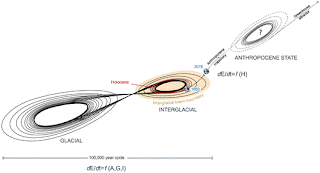Quantifying The Risk Of Climate Change
It's possible to quantify the risk to our planet from climate change. And it doesn't look good for civilization. (h/t Alternet)
Read the original article for the best information on this model.
Human activities now rival the great forces of nature in driving changes to the Earth System (Steffen et al., 2007). This has led to the proposal that Earth has entered a new geological epoch – the Anthropocene (Crutzen, 2002; Crutzen and Stoermer, 2000).[....]
For biodiversity, typical rates of background extinction are estimated to be around 0.1 extinctions/million species years (De Vos et al., 2015). Current extinction rates are estimated to be tens to hundreds of times higher than natural background rates of extinction (Barnosky et al., 2012; Ceballos et al., 2015). Humans have now modified the structure and functioning of the biosphere to such an extent that the Anthropocene may mark the beginning of a third stage in the evolution of Earth’s biosphere, following the microbial stage from ~3.5 Ga BP and the metazoan from ~650 Ma (Williams et al., 2015).[....]
Figure 2 shows a potential future trajectory of the Earth System in the Anthropocene, with the system in 2016 poised at a critical position. Remaining within the interglacial conditions of the late Quaternary will require the exceptionally rapid rate of change of the Earth System to return to close to zero, with human forcings reduced to levels less than, or at least comparable to, astronomical and geophysical forcings and the internal dynamics of the Earth System. Sustained human pressures risk abrupt exiting of the glacial–interglacial limit cycle of the late Quaternary (Clark et al., 2016; Ganopolski et al., 2016), and ushering in Earth’s sixth great extinction event (Barnosky et al., 2012).
In the case of the Anthropocene, efforts to achieve the long-term viability of a global civilisation – global sustainability – implies that Homo sapiens will deliberately and rapidly reduce its impacts on the Earth System so that they are more comparable in magnitude and more synergistic with A, G and particularly I. Alternatively, continued increases in H could well lead to abrupt changes in the Earth System that could trigger societal collapse, forcibly reducing H dramatically and returning control of the system to A, G and I. The legacy of the impacts of H on I through changes in the biosphere could, however, be discernible in the internal dynamics of the Earth System for millions of years (Williams et al., 2015).
Read the original article for the best information on this model.



Comments
Post a Comment